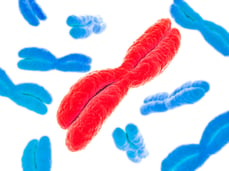Originally published : Thu, November 10, 2016 @ 8:15 PM
Updated : Wed, March 29, 2023 @ 10:51 AM
The strands of DNA in your cells are organized into pieces called chromosomes. Chromosomes are further organized into short segments of DNA called genes. If you imagine your DNA as a cookbook, then your genes are the recipes and the chromosomes are the ingredients.
are further organized into short segments of DNA called genes. If you imagine your DNA as a cookbook, then your genes are the recipes and the chromosomes are the ingredients.
Different organisms have different numbers of chromosomes that are in a cell’s nucleus and they almost always are in pairs. Humans have 23 pairs of chromosomes, chimpanzees have 24, bananas have 11 and fruit flies have 4 (who would think a banana would have more). Many inherited disorders are caused by mutations in specific genes, but some are caused by abnormal chromosomes.
T.H. Morgan began experimenting with fruit flies in 1908. One of the reasons fruit flies were selected is that they can lay 800 eggs a day and produce a new generation every two weeks! Most fruit flies have red eyes, but he found one male that had white eyes. When a red-eyed female was mated with the mutant white-eyed male. All of the offspring had red eyes. He then mated that generation of flies together and the white-eyes came back, but only in about one-half of the males and none of the females. This was the first experiment to show that the mutant gene was recessive and carried on the female X chromosome.
In X-linked recessive disorders, men are affected and women are carriers, with the most common disorders being red-green colour blindness and haemophilia. See the drawing below which shows the four different chromosome combinations that a son or daughter could inherit from a mother who is a carrier of the chromosome disorder and a father who is not. Only a son could have the condition since the X chromosome provided by the father is always healthy, with a 50% chance of inheriting the affected X chromosome from his mother. A daughter can’t have the condition if her father doesn’t sufferer from it, but has a 50 percent chance of being a carrier, depending on which X gene she gets from her mother.

So, now that we have those great red tomatoes and fall fruits in the house, don’t hate the fruit flies when they show up. Say thank you for helping us better understand genetics. Then, get the fly swatter.
Reference:
Henderson, Mark, Joanne Baker, and A. J. Crilly. "Chapter 3 - Genes and chromosomes." 100 Most Important Science Ideas: Key Concepts in Genetics, Physics and Mathematics.

